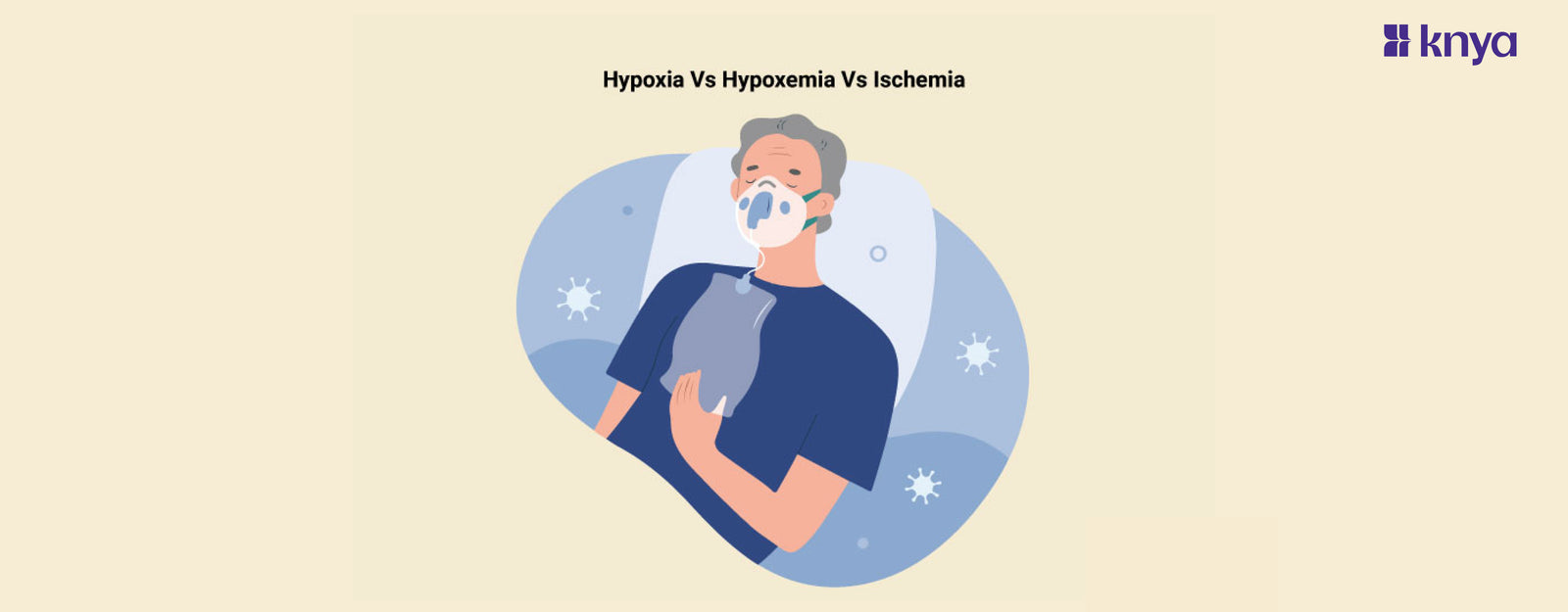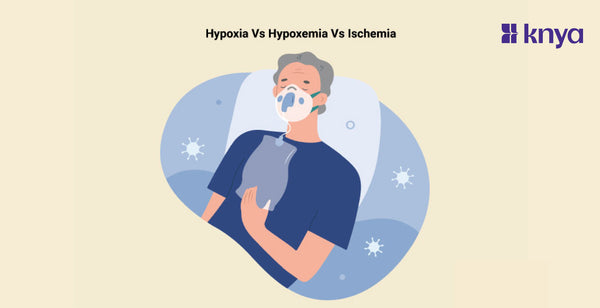Hypoxia vs Hypoxemia vs Ischemia: Hypoxia, Hypoxemia, and Ischemia are three distinct but related conditions involving oxygen deprivation in the body. Hypoxia is characterized by insufficient oxygen flow to tissues and organs, which can be caused by a variety of factors such as respiratory illnesses, cardiovascular disease, or high altitude exposure. Hypoxemia, on the other hand, refers particularly to low oxygen levels in arterial blood caused by diseases that impede oxygen intake in the lungs or reduce blood oxygen-carrying capacity. Ischemia is a condition characterized by decreased blood flow and oxygen delivery to tissues, which is frequently caused by restricted or blocked blood arteries. While Hypoxia and Hypoxemia indicate insufficient tissue oxygenation, ischemia indicates impaired blood flow, which can lead to tissue injury or dysfunction. Understanding these distinctions aids in the correct diagnosis and appropriate care of certain oxygen-related illnesses.
Difference between Hypoxia vs Hypoxemia vs Ischemia
Hypoxia refers to insufficient tissue oxygenation caused by factors such as respiratory or cardiovascular illnesses, whereas Hypoxemia refers to low oxygen levels in the arterial circulation, which are frequently caused by lung or heart disease. Ischemia is defined as decreased blood flow and oxygen delivery to tissues, which is usually caused by restricted or blocked blood arteries and can cause a variety of symptoms such as chest pain or tissue necrosis. The table below summarizes the differences between Hypoxia, Hypoxemia, and Ischemia.
|
Aspect |
Hypoxia |
Hypoxemia |
Ischemia |
|
Definition |
Inadequate oxygen supply to tissues and organs |
Low oxygen levels in arterial blood |
Reduced blood flow and oxygen delivery to tissues |
|
Cause |
Respiratory disorders, cardiovascular diseases, anemia, high altitudes, exposure to toxins |
Lung diseases, heart conditions, anemia, high altitudes |
Narrowed or blocked blood vessels, coronary artery disease, stroke, peripheral artery disease, embolism |
|
Symptoms |
Shortness of breath, rapid breathing, confusion, dizziness, cyanosis, eventual organ dysfunction |
Shortness of breath, rapid heart rate, confusion, dizziness, cyanosis |
Chest pain (angina), limb pain, neurological deficits, tissue necrosis |
|
Diagnosis |
Clinical evaluation, arterial blood gas analysis |
Arterial blood gas analysis (measuring PaO2), other diagnostic tests as needed |
Clinical evaluation, imaging studies (angiography, MRI), laboratory tests (cardiac enzymes, troponin) |
|
Treatment |
Supplemental oxygen therapy, addressing underlying medical conditions, supportive care |
Supplemental oxygen therapy, addressing underlying conditions, supportive measures to enhance lung function |
Medications, revascularization procedures, lifestyle modifications, management of risk factors |
Browse The Best Scrubs Collection!
What is Hypoxia?
Hypoxia happens when your body's tissues do not receive adequate oxygen. When you breathe, oxygen enters your lungs and travels through your airways, exiting into little sacks known as alveoli. It is then caught up by your blood in small veins near the alveoli (capillaries). Finally, it passes through your blood to various tissues.
Features of Hypoxia
- Cyanosis: Cyanosis is defined as a bluish staining of the skin, lips, or nail beds caused by low blood oxygen levels.
- Breathing Issues: Shortness of breath is defined as difficulty breathing or a sensation of being out of breath caused by insufficient tissue oxygenation.
- Rapid Heart Rate: Rapid heart rate occurs when the body seeks to supply more oxygenated blood to tissues.
- Risk Management: The best way to reduce the risk is to manage any underlying conditions that can reduce the oxygen levels.
Causes of Hypoxia
- Respiratory Problems: Respiratory problems include pneumonia, chronic obstructive pulmonary disease (COPD), asthma, and respiratory distress syndrome, which can all limit oxygen exchange in the lungs.
- Cardiovascular diseases: Heart failure, heart attack, and other cardiac illnesses can limit blood flow to tissues, resulting in insufficient oxygen delivery.
- Anemia: A low red blood cell count or decreased hemoglobin function decreases the blood's ability to transport oxygen to tissues.
- Carbon monoxide poisoning: The inhalation of carbon monoxide, a colorless and odorless gas, can disrupt oxygen delivery in the blood.
- Cyanide poisoning: Exposure to cyanide, a poisonous chemical molecule, can disrupt cellular oxygen use, resulting in Hypoxia.
Symptoms of Hypoxia
- Shortness of breath or trouble breathing.
- Rapid or shallow respiration
- Cyanosis
- Rapid heartbeat or palpitations
- Chest ache or tightness
- Nausea or vomiting
- Confusion or disorientation
- Dizziness or lightheadedness
- Fatigue or weakness
- Headache
What is Hypoxemia?
Hypoxemia is a condition characterized by low levels of oxygen in the blood, particularly in the arterial circulation. This can happen owing to a variety of causes that restrict the efficient exchange of oxygen in the lungs, reduce the oxygen-carrying capacity of the blood, or obstruct gas exchange. Shortness of breath, fast heart rate, disorientation, dizziness, and cyanosis (bluish skin discoloration) are all possible symptoms of Hypoxia. The diagnosis is often verified by arterial blood gas analysis, which measures the partial pressure of oxygen (PaO2) in arterial blood. Treatment seeks to address the underlying cause, which may include supplementary oxygen therapy, mechanical ventilation, or drugs to improve lung function.
Features of Hypoxemia
- Cyanosis: Cyanosis is a bluish coloring of the skin, lips, or nail beds caused by low oxygen saturation in arterial blood.
- Dyspnea: Shortness of breath (dyspnea) is defined as difficulty breathing or a feeling of being out of breath, particularly during exercise or at rest.
- Rapid breathing (tachypnea): An increase in respiratory rate as the body tries to adjust for low oxygen levels.
- Rapid heart rate (tachycardia): An elevated heart rate in reaction to Hypoxia, to improve oxygen delivery to tissues.
- Confusion or cognitive changes: Reduced mental clarity or changed consciousness as a result of poor brain oxygenation.
- Restlessness or agitation: Behavioral changes caused by Hypoxemia-related discomfort or distress.
Causes of Hypoxemia
- Pulmonary vascular disorders: Conditions affecting the lungs' blood arteries, such as pulmonary hypertension or pulmonary embolism, can reduce blood flow and gas exchange.
- Lung trauma or injury: Damage to the chest or lungs, such as rib fractures or lung contusions, can impair normal lung function and result in Hypoxemia.
- Chronic respiratory failure: Obesity hypoventilation syndrome and neuromuscular diseases can cause long-term blood oxygenation deficiencies.
- Environmental exposure: Inhaling hazardous substances such as smoke, chemicals, or pollution can harm lung tissue and limit oxygen intake.
- Sleep-disordered breathing: Conditions such as obstructive sleep apnea and central sleep apnea can cause brief periods of low oxygen levels while sleeping.
- Respiratory muscular weakness: Respiratory muscular weakness refers to the weakness or paralysis of the muscles that control respiration.
Symptoms of Hypoxemia
- Anxiety
- Rapid heart rate (tachycardia)
- Rapid breathing (tachypnea)
- Dyspnea (difficulty breathing
- Slow heartbeat (bradycardia)
- Excessive restlessness
- Restlessness.Headache
- Confusion
- Bluish skin (cyanosis)
What is Ischemia?
Ischemia is a medical term that refers to a situation in which the body's tissues or organs receive less blood flow and oxygen. It is usually caused by restricted or clogged blood arteries, which prevents enough oxygen-rich blood from reaching the affected area. Ischemia can affect any organ or tissue in the body, including the heart, brain, limbs, and intestines. The absence of oxygen and nutrients in ischemic tissues can cause cellular injury, malfunction, and, in severe and prolonged cases, tissue death (necrosis). Ischemia can be caused by a variety of diseases, including atherosclerosis, thrombosis, embolism, vasospasm, or trauma.
Features of Ischemia
- Pain or discomfort: Ischemia frequently causes pain or discomfort in the affected location, such as chest pain (angina) in coronary Ischemia or limb pain in peripheral ischemia.
- Pallor: Skin paleness caused by diminished blood flow and oxygenation to the tissues. The affected area may feel chilly to the touch due to diminished blood flow.
- Weakness or numbness: Reduced function or feeling in the affected area as a result of insufficient oxygen and nutrient availability to the nerves and muscles.
- Risk Factors: Ischemia may develop more commonly in people who have atherosclerosis, hypertension, diabetes, smoking, obesity, or a sedentary lifestyle.
- Triggers: Physical exercise, stress, cold temperatures, and certain drugs can all cause or worsen Ischemia.
Causes of Ischemia
- Atherosclerosis: Atherosclerosis is the buildup of plaque within the arteries, which causes constriction and restricted blood flow. This is a prevalent cause of coronary artery disease, peripheral artery disease, and cerebrovascular illness.
- Thrombosis: Thrombosis is the formation of blood clots within blood vessels, which can occlude the vessel and prevent blood flow. Endothelial injury, hypercoagulable conditions, or sluggish blood flow are all potential causes of thrombosis.
- Embolism: Embolism is the movement of a blood clot (embolus) from one portion of the body to another, where it becomes trapped in a smaller artery and disrupts blood flow. Emboli can come from the heart (atrial fibrillation, myocardial infarction), deep vein thrombosis, or arterial plaques.
- Vasospasm: Vasospasm is the constriction or narrowing of blood vessels caused by an abnormal contraction of smooth muscle in the vessel walls. Vasospasms can occur spontaneously or be caused by several causes, including cold exposure, stress, and some drugs.
- Trauma: Damage to blood vessels or tissues, such as from blunt trauma, penetrating injuries, or surgical procedures, can disrupt blood flow and result in ischemia.
Symptoms of Ischemia
- Numbness
- Confusion
- Fatigue
- Cognitive alterations
- Chest discomfort
- Shortness of breath
- Weakness
- Altered sensation
- Motor deficiencies
Shop Best Lab Coats From Here!
Similarities between Hypoxia, Hypoxemia and Ischemia
- Oxygen supply: All three disorders result in a disturbance in the usual flow of oxygen to the body's tissues or organs.
- Tissue damage: Chronic or severe Hypoxia, Hypoxemia, or Ischemia can cause tissue damage, malfunction, and cell death.
- Symptoms: Symptoms of Hypoxia, Hypoxemia, and Ischemia may coexist, including shortness of breath, disorientation, weariness, and cyanosis.
- Underlying causes: Respiratory problems, cardiovascular diseases, and some environmental variables may overlap.
- Medical urgency: To avoid complications and enhance results, all three disorders must be identified and managed promptly.
In summary, Hypoxia, Hypoxemia, and Ischemia all involve insufficient oxygen flow to tissues, but they differ in their underlying mechanisms, causes, manifestations, and therapeutic approaches. Hypoxia is defined as systemic oxygen deprivation, Hypoxemia as low oxygen levels in arterial blood, and Ischemia as a reduction in blood flow to tissues or organs.
Order the Best Jogger Scrub From Here!
| Check out More Articles | |
| Difference Between Cartilage and Bone | |
| Difference Between Endocrine and Exocrine Glands | |
| Difference Between Cell Wall and Cell Membrane | |















